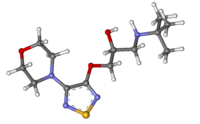 | |
 | |
| Clinical data | |
|---|---|
| Trade names | Timoptic, others[1] |
| AHFS/Drugs.com | Maleate Monograph eent Monograph |
| MedlinePlus | a684029 |
| License data | |
| Pregnancy category |
|
| Routes of administration | By mouth, topical (eye drop) |
| Drug class | Beta blocker |
| ATC code | |
| Legal status | |
| Legal status | |
| Pharmacokinetic data | |
| Bioavailability | 60% |
| Metabolism | Liver (80%, mainly CYP2D6[4]) |
| Onset of action | 15–30 min[3] |
| Elimination half-life | 2.5–5 hours |
| Duration of action | 24 hours[3] |
| Excretion | Kidney |
| Identifiers | |
| |
| CAS Number | |
| PubChem CID | |
| IUPHAR/BPS | |
| DrugBank | |
| ChemSpider | |
| UNII | |
| KEGG | |
| ChEBI | |
| ChEMBL | |
| CompTox Dashboard (EPA) | |
| ECHA InfoCard | 100.043.651 |
| Chemical and physical data | |
| Formula | C13H24N4O3S |
| Molar mass | 316.42 g·mol−1 |
| 3D model (JSmol) | |
| |
| |
| (verify) | |
Timolol is a beta blocker medication used either by mouth or as eye drops.[3][5] As eye drops it is used to treat increased pressure inside the eye such as in ocular hypertension and glaucoma.[3] By mouth it is used for high blood pressure, chest pain due to insufficient blood flow to the heart, to prevent further complications after a heart attack, and to prevent migraines.[5]
Common side effects with the drops is irritation of the eye.[3] Common side effects by mouth include tiredness, slow heart beat, itchiness, and shortness of breath.[5] Other side effects include masking the symptoms of low blood sugar in those with diabetes.[3] Use is not recommended in those with asthma, uncompensated heart failure, or chronic obstructive pulmonary disease (COPD).[3] It is unclear if use during pregnancy is safe for the fetus.[6] Timolol is a non-selective beta blocker.[3]
Timolol was patented in 1968, and came into medical use in 1978.[7] It is on the World Health Organization's List of Essential Medicines.[8] Timolol is available as a generic medication.[3][9] In 2022, it was the 155th most commonly prescribed medication in the United States, with more than 3 million prescriptions.[10][11]
- ^ Cite error: The named reference
genericnameswas invoked but never defined (see the help page). - ^ "Product monograph brand safety updates". Health Canada. February 2024. Retrieved 24 March 2024.
- ^ a b c d e f g h i "Timolol eent". The American Society of Health-System Pharmacists. Archived from the original on 28 December 2016. Retrieved 8 December 2016.
- ^ Volotinen M, Turpeinen M, Tolonen A, Uusitalo J, Mäenpää J, Pelkonen O (July 2007). "Timolol metabolism in human liver microsomes is mediated principally by CYP2D6". Drug Metabolism and Disposition. 35 (7): 1135–1141. doi:10.1124/dmd.106.012906. PMID 17431033. S2CID 794764.
- ^ a b c "Timolol Maleate". The American Society of Health-System Pharmacists. Archived from the original on 28 December 2016. Retrieved 8 December 2016.
- ^ "Timolol ophthalmic Use During Pregnancy". The American Society of Health-System Pharmacists. Archived from the original on 28 December 2016. Retrieved 28 December 2016.
- ^ Fischer J, Ganellin CR (2006). Analogue-based Drug Discovery. John Wiley & Sons. p. 460. ISBN 9783527607495. Archived from the original on 28 December 2016.
- ^ World Health Organization (2023). The selection and use of essential medicines 2023: web annex A: World Health Organization model list of essential medicines: 23rd list (2023). Geneva: World Health Organization. hdl:10665/371090. WHO/MHP/HPS/EML/2023.02.
- ^ "Competitive Generic Therapy Approvals". U.S. Food and Drug Administration (FDA). 29 June 2023. Archived from the original on 29 June 2023. Retrieved 29 June 2023.
- ^ "The Top 300 of 2022". ClinCalc. Archived from the original on 30 August 2024. Retrieved 30 August 2024.
- ^ "Timolol Drug Usage Statistics, United States, 2013 - 2022". ClinCalc. Retrieved 30 August 2024.